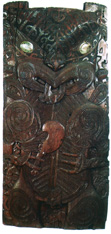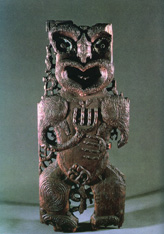|
Approach: One
to one
|
| Focus:
Students
can identify and discuss the special features and symbolism of traditional Mäori
carvings.
|
 |
6.1Megs |
Resources: Set
A: 5 pictures of carvings from around the world; set B: 3 pictures of Mäori
carvings Note: Year 8 students used 3 pictures of Mäori carvings; year 4
students used 2 of the 3 pictures; |
|
Questions / instructions:
|
|
Lay
out Set A pictures for student to view.
People in different parts of the world make carvings out of wood, bone, stone
or other things.
Some carvings are very special to the people of the country where they are made.
|
%
responses
|
|
y4
|
y8
|
| 1.
Can you point to a carving that is special to people in New Zealand? |
Picture
of carving selected as being special to the people of New Zealand: |
.
|
.
|
|
picture
1
|
0
|
.
|
|
2
|
4
|
.
|
|
3
|
91
|
99.5
|
|
4
.
|
4
|
0
|
|
5
|
5
|
1
|
2.
Which people in New Zealand would this carving be special to?
Prompt: Anyone else? |
Identification
of people in New Zealand for whom the selected carving is special: |
.
|
.
|
|
chose
picture 3 and identified Mäori and Pakeha
|
18
|
23
|
|
chose
picture 3 and identified Mäori
|
69
|
77
|
|
chose
picture 3 and identified other
|
4
|
0
|
|
chose
any other picture
|
9
|
0
|
|
Lay out Set B pictures for student to view.
Here are some pictures of wood carvings made by Mäori. Each carving is a
human figure.
| Pcitures of
Mäori Carvings |
(Year 8 only) |
 |
 |
 |
|
3.
Why do you think Mäori carvers made these carvings of human figures?
Who might these carved figures be? |
Identification
of reasons why the Mäori carvings were made, and who or what they symbolise: |
.
|
.
|
|
symbolise
genealogy/ancestors
|
50
|
64
|
|
symbolise
gods/warriors/taniwha
|
35
|
60
|
|
symbolise
protections or tapu
|
6
|
12
|
|
tell a legend/story
|
15
|
17
|
| 5.
Where would you expect to see carvings like these? Prompt: In what sort of
places would the carvings be put? |
Identification
of places where these carvings might be seen:
|
.
|
.
|
|
marae/meeting
house
|
72
|
93
|
|
open
public places
|
31
|
30
|
|
museums
|
36
|
42
|
|
media/text/reproductions
|
8
|
6
|
| 6.
Look carefully at each carving and you will notice that they all have some special
features. The special features are similar in each carving. Try to describe to
me all of the special features that are seen on each carving. |
Identification
of special features of the carvings: |
. |
. |
|
made
of wood; brown in colour; spiral carved patterns; curved tongues–out of mouth;
eyes–paua/slanted/indentation; mouth shape–figure 8 or heart shaped;
hands–number of fingers; hands–resting on abdomen; holding a weapon;
small figure/baby between legs.
|
.
|
.
|
|
Number
of relevent features mentioned:
|
.
|
.
|
|
7
or more
|
2
|
7
|
|
4–6
|
39
|
48
|
|
2–3
|
48
|
38
|
|
1
|
8
|
5
|
|
0
|
3
|
2
|
|
Richness
of description of features of the carvings:
|
.
|
.
|
|
rich
elaboration on several features
|
0
|
1
|
|
rich elaboration on 1 or 2 features
|
6
|
10
|
|
little elaboration
|
94
|
89
|
Commentary:
A good
percentage of year 4 and year 8 students recognised the significance, symbolic
meaning and usual location of Mäori carvings like those shown in the photographs.
Identification and descriptive explanation of observable features of the carvings
proved more demanding for many students. |